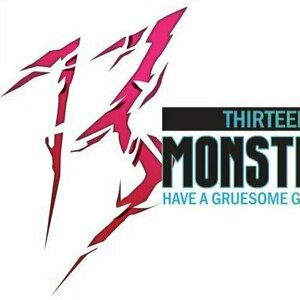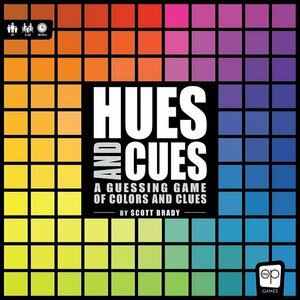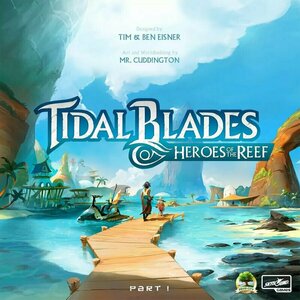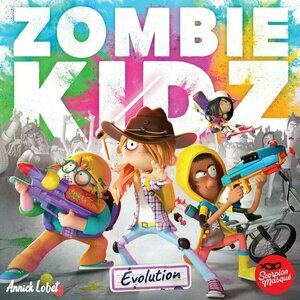
Quests of Valeria
Tabletop Game
In Quests of Valeria you play the role of a Guild Master, recruiting and dispatching Citizens to...

Animal Attraction (San Francisco Dragons #2)
Book
What do you do when an NHL player steals your dog and won’t give it back? Maggie Hudson made a...
Contemporary Sports Romance
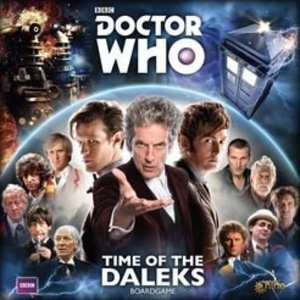
Doctor Who: Time of the Daleks
Tabletop Game
"Exterminate!" They muttered about their sacred hatred, the Oncoming Storm. Their creator had a...

Bermuda Pirates
Tabletop Game
The Bermuda Triangle has been known for its treacherous sea. An adventurous band of pirates has set...

Game Changer (Vancouver Orcas #2)
Book
It’s Blair Brawsiski’s ride or die year. After a decade in the AHL, if he doesn’t get called...
Contemporary MM Sports Romance
Purple Phoenix Games (2266 KP) rated 13 Monsters in Tabletop Games
Dec 5, 2019
As I mentioned in the intro, and as you can see in the first photo below, 13 Monsters starts out as a memory tile-flipping game and then becomes a bash-em’-up for domination. The goal of 13 Monsters is to end the game holding the monsters with the highest total Hit Points (HP). Now how you get there is another matter entirely.
DISCLAIMER: We were provided a prototype copy of this game for the purposes of this review. These are preview copy components, and I do not know for sure if the final components will be any different from these shown. Also, it is not my intention to detail every rule in the game, as there are just too many. You are invited to download the rulebook, purchase the game through the Kickstarter campaign running until December 20, 2019, or through any retailers stocking it after fulfillment. -T
To setup 13 Monsters, a randomized 9×9 grid of monster tiles are spread across the play surface with the longer title tile placed square in the middle (see what I did there?). Place the five d6 on the table to be used by any player. Determine the first player (whomever is the most beastly) and you are ready to play!
Turns are played in phases where you will initially be hunting the playing field trying to find matching monstersets to build a complete monster. Monstersets are horizontally matching tiles belonging to the same monster. So the top set is the head, the middle is the eyes, and the bottom is the body of the monster. This phase will continue in turns until multiple players have at least one monsterset. Things now start getting interesting.
Once you have at least one monsterset you can, before hunting from the field, offer to trade monstersets with other players. You may also use an ability named “Sacrifice,” which allows you to rearrange your monstersets to create a more powerful monster. Why would you want to rearrange? Monsters come in five elemental flavors – fire, water, earth, air, and ghost. Monsters with matching elemental monstersets are more powerful than those with mismatched elemental monstersets. This will come into play later when the monsters battle for supremacy.
Battles. Once you have a complete monster (head, eyes, body) you can, on your turn and before hunting, attack another monster. When attacking, both the attacker and defender will be throwing the five dice in hopes of ending with the highest total of pips of a matching set (like five 6s on the d6). The winner will then claim a monsterset from the involved monster (or separate monsterset) and add it to their collection. Monsters with more elementally-matching sets will be able to throw the dice more times versus a completed monster with mismatched elemental sets, so THAT is why using Sacrifice can make or break a battle.
There are other special abilities that are unlocked with different combinations of monsters: “Permafrost” allows the player to place a die on a tile that other players will not be able to flip on their hunting turn. However, once a battle is initiated all Permafrost dice are removed from the board to be used in the battle, so it is not a long-term tactic to be used. “Prophet” allows the player to flip over three tiles instead of the normal two tiles and can be very powerful when used correctly – you need to have a “Monster O.G.” which is a monster with all matching tiles belonging to the same completed monster. The final ability is “Supernova” and can only be used by a completed 13th Monster (the only Ghost-element monster, shown below). Supernova allows the player to sacrifice the 13th Monster in order to absorb (steal) a complete monster from any player and add it to their personal collection. The 13th Monster then leaves the game, but the controlling player will still receive the HP points for having collected and used it.
Play continues in this fashion until all tiles have been collected from the playing field. Once the final pair is taken, players are then allowed to declare one final battle against any opponent in hopes to bolster their final score. The player with the most HP shared among their completed monsters is the winner and ultimate Beast Master!
Components. Again, we were provided a prototype copy of the game, but from what I understand, the final production copy of the game will be very similar to this version if not exactly the same. What comprises the game is a ton of monster tiles and five dice. That doesn’t sound like a lot, and it’s not. But these are great quality tiles and normal quality dice (which I am hoping will become pink to match the main color found throughout the game). I love the overall art style. The art is what really pops out at you because the monsters are all uniquely weird and intriguing and kinda cute at the same time. I also very much appreciate that the team thought to include little bubbles next to the element icon on the tiles to indicate to which layer the tile belongs: head, eyes, body. Excellent touch. Overall the components are great, and the rulebook is killer. Outstanding work went into making this game visually stunning.
Is it a good game? It is certainly a very cool spin on Memory and adds modular monster building and player vs player battles where you can win each others’ components. I love it! Even though I am horrible at memory games, this gives me options once I do find a monsterset. I can trade and attack my way to building more and better monsters – but the dice have to be on my side, and I’m cool with that. If you are looking for something to add to your collection that is a brilliant hybrid of many different mechanics and looks absolutely incredible on the table, then please check out 13 Monsters. It rewards tactics, but also has that element of luck to help balance everything out. I’m a big fan!
Purple Phoenix Games (2266 KP) rated Hues and Cues in Tabletop Games
Jul 7, 2020 (Updated Jul 7, 2020)
Hues and Cues is a party game of describing colors using one- and two-word cues (a la the hit game show Password from back in the day). As each player is attempting to guess the correct color, and populate the areas immediately adjacent to it, chances for big-time points are plentiful, but I’ll tell you what – coming up with cues proves to be a bit more challenging than one might assume.
DISCLAIMER: We were provided a retail copy of this game for the purposes of this review. Though I know the designer personally, I will be reviewing this game as an impartial judge. -T
To setup a game of Hues and Cues, shuffle the large deck of cue cards to be drawn from, lay out the giant board, set aside the scoring frame for now, and give each player the three cones of their selected color. Place one of these cones on the board to be used as a scoring token, and the game is ready to be played!
A game of Hues and Cues will be played over several rounds where each player will act as the cue giver for at least one round, depending on number of players (unless you play with my wife, in which case games can last many many more rounds than suggested). The cue giver will draw a card from the deck, choose a color hue from it, and think of a one-word cue to offer the group. Once the cue is given, in clockwise fashion, each other player will place one of their cones on a color box on the main board. Once complete, the cue giver will then offer a two-word cue to the group, if they so choose… Again the players will place their other cone in a box (either near their original choice or somewhere completely different). When all players have placed their second cone, the cue giver will place upon the board the scoring frame with the chosen hue’s coordinates directly in the center of the frame.
If a player has placed a cone directly on the correct coordinate box, they score 3 points. If a cone resides within the scoring frame (the other 8 boxes surrounding the correct box), they receive 2 points. For every cone just outside the scoring frame surrounding it, the player will receive 1 point. For each cone within the scoring frame the cue giver will score 1 point.
The game ends after each player has had one or two turns to be cue giver, depending on player count and house rules for game end rounds. The player with the most points will be deemed the winner and will have quality bragging rights for the night.
Components. Guys and gals, these components are great. The board is HUGE, but also necessary because there are tons of color hues printed on it. The cards are nice, and the game comes with a giant stack of them. The cones are colored cones. There’s orange and purple and some others colors I think too (I really only care about orange and purple usually). The scoring frame takes a bit to get used to, but is necessary to visualize which cones receive the correct amount of points. The Op comes through again with some choice components here.
So again, I personally know the designer and want to offer that disclaimer. That said, whether I know him or not, this is another great game. I reviewed Gekitai some months ago and was enamored with it as a wonderful abstract, and Hues and Cues gets me again. I love the components, the game play is simple and fast, and I haven’t really played a game too similar. I guess the closest games I can compare it to would be Concept and Codenames. You have to be very exact when giving cues to others (Concept) using one-word and two-word cues (Codenames). It seems super easy to be able to describe a color, but when you look at your chosen hue and can’t even think of a one-word cue and you’re just sitting there while the other players are anxiously awaiting your utterance, you can feel the confidence sweating out of your body.
For one example of actual gameplay, a cue was given, “Western.” My wife and I, alums of Western Illinois University, immediately started finding the correct purple hue because WIU’s colors are purple and gold. However, another player started searching the browns because they thought the cue was guiding the players to Western movies or the Wild West. So there may be conflicts, or different ideas and interpretations of the cues given that can make the whole group giggle incessantly, or times where the game is near the end and you know you need at least 3 points to be in the running and you reallllllly want to hit on the exact hue. So this one can make you feel like you are Bob Ross colormaster, or like you can’t even remember what red even is anymore.
That said, this is NOT a game for our colorblind friends, as it revolved heavily on being able to distinguish color differences, but for everyone else this is a hit. I love that I have to think of things and items and concepts in terms of color to describe instead of any other values, and that is very challenging for me. I love being able to look at the board and have 20 options when the cue given is, “Penny.” I love laughing at some of the amusing cues given or trying to figure out what the hey someone even means with their cues. It’s a wonderful stressful game (for me and the way my mind works) but it has gone over smashingly with everyone to whom I have introduced it. If you are looking for a uniquely-themed party (!) game that isn’t an Apples to Apples or Mafia clone, then you certainly owe it to yourself to check out Hues and Cues. Purple Phoenix Games gives this one a rainbowy 11 / 12. Hugh Jackman would certainly approve, and would probably like to come to your house to play your copy.
Purple Phoenix Games (2266 KP) rated Tidal Blades; Heroes of the Reef in Tabletop Games
Apr 20, 2021
DISCLAIMER: As this game is a giant and many reviewers are starting to tackle it using multiplayer rules, I decided I would talk about the differences between multiplayer and solo rules. This review is using the included Solo Mode rules.
Setup for the Solo Mode uses most of the setup rules for the multiplayer game with a few exceptions. In the Solo Mode the player will have one character to control and one Rival to beat. The Rival will need their player board and standee or mini (I have the Deluxe Edition, so it’s minis in my case). In addition, the player will also choose two other characters to be Allies, utilizing their ability cards and minis. The Allies and Rival will be placed on the Champion board ahead of the player to begin the game. The player wins by having more points than the Rival at the end of the game.
Quickly, here is Tidal Blades in a nutshell. Players are attempting to gather the greatest standing on the Champion board (like a VP track) and VP from Challenge cards gained. The players earn these cards by using Actions to move to islands, gather resources, fight monsters, perform boating maneuvers and tricks, and can increase the potential for each of these by upgrading their central board dials. Shells and Fruit are common resources, and each player starts with two Actions per turn. The game lasts four total Days (or phases with several turns in each), and players earn more Action discs on Day two and four. Every time the dice are rolled to complete Challenges a Danger Die is also rolled and can wound the player by forcing a discard of dice. Each Day players can refresh and upgrade used dice to better their skill and concentrate their abilities. After Day four the game ends and players count up points to declare a victor!
Here is how gameplay is slightly different from the multiplayer experience. The Rival always goes first. They will also have one more Action disc to use on their turn (unfair, right?). When they begin their turn, a Challenge card is drawn. Whichever Island is featured on the card is to where the Rival will travel. Once arrived, the amount of VP awarded on the card is how many spaces from the top of the Island the Rival will be placed. Depending upon which Island the Rival ends the Challenge card will then be placed under the Solo Mode mat and a special action taken. The special actions could be revealing and resolving a Plot card in Droska Ring (special to Solo Mode), removing Monster hits from the Fold in the Chronosseum, or moving the boat in Lamara Stadium. The Judge location also plays a role in special actions should the Rival land on the same Island as they are. Other special goodies await, but I will leave you to discover those.
On the player’s turn, if the player is tied with or ahead of their Allies on the Champion board, the player will be able to use the Allies on their turn. This is handled similar to having an extra Action disc on the player’s turn. Send the Ally to a location and reap the rewards. Otherwise, for the player, turns are the same.
Components. Let me tell you: if you have the extra money to splurge for the Deluxe Edition, DO IT. The minis are amazing, the plastic shells are awesome, and those squishy fruit are so perfect! Obviously the game is perfectly playable and enjoyable with the basic components, but the improved bits are really something special. The cardboard everything is great, the GameTrayz inserts are incredible, and the art and colors are simply magical. I cannot say enough excellent things about what comes in this massive box. Druid City Games and Skybound Tabletop got everything right with this one.
It should be no surprise that I am in love with this game. Yes, it’s a Solo Chronicles, and I played by myself. I get that. Eventually I will be able to play this with others and by then I will be so engrossed in the lore that I will have no problems hyping up my playmates. Tidal Blades is an absolutely gorgeous game with so much going on that I don’t think I will ever tire of it. The game lasts four days but I wish it were a month because I just want to keep playing! The decisions to be made are all wonderfully delicious and there always seems to be too few on your turn. Yes, I know that sounds like all worker placement games, but it is especially true here. Almost every spot on the board gives immediate benefits that can be used, so even when a location is occupied, there will always be another of equal importance to your character. It’s so good.
Like I said before, I love the art and colors used. This is a stunner of a game on the table. It does take up quite a bit of room, especially if you use the arena dice tray (which I didn’t because I play at night when the kids are asleep and a hard plastic dice tray wakes up children). I count myself lucky to have the Deluxe Edition as well because those upgraded bits really make the game feel deluxe and fancy.
The Solo Mode is very good, and at least for me, very difficult to win. The combination I used for this review was playing as Axl against my Rival Caiman. Obviously switching out characters and using different Allies will change up the feel a bit, and I really cannot wait to try out all the permutations. When a game begs you to play it as often as you can and you look at it lovingly on your shelf, you know you have a Top 10 game, and a treasure in your collection.
Purple Phoenix Games (2266 KP) rated Zombie Kidz Evolution in Tabletop Games
Nov 9, 2021
Zombie Kidz Evolution is a cooperative, horror/zombies, dice rolliling, variable player powers, LEGACY game… for children?? Those mechanics do not scream “children” to me at all! What gives here? In this one, players take on the role of children protecting their schoolhouse from infiltrating zombies, and all players win or lose together. Through multiple plays, however, the game evolves and the way in which the game is played also evolves. Oh, and there’s also stickers, which ALL children love.
To setup, determine play count and which side of the board to play. Each player chooses a standee to represent them, place out one zombie tile in each area with a fence gate, and the other zombies randomly in a line near the board. The lock tokens should be placed nearby and the die is given to the starting player (in our house, my son, as he will cry if we didn’t). The player standees, “kids” from here out, are placed in the central room of the schoolhouse and the game is ready to begin!
Zombie Kidz Evolution is played over several turns, and each turn consists of three or four actions. First, the active player rolls the die. The die face determines in which school zone a zombie tile will spawn. There are five colored spaces relating to five of the six die faces, with one die face being blank – no zombies spawn on that roll. After placing the zombie tile in the appropriate zone, the player may move their kid to an adjacent zone or leave them where they are. However, if a zone contains three or more zombies, the kids cannot enter.
After movement, the player may then eliminate one or two zombies in their zone. This happens automatically – there are no combat mechanics. The player simply removes one or two zombie tiles and places them at the end of the line off-board. Should two kids occupy the same zone outside the school where a fence gate is unlocked, they may high-five and place a lock token on the gate. After this step, the die is passed to the next player for their turn.
The game continues in this fashion of taking turns spawning and eliminating zombies until the players have locked all four gates outside the schoolhouse. A brain sticker is applied to the appropriate space on the back of the rulebook to track victories, and if enough stickers have been applied, players may be allowed to open one of the 13 sealed envelopes. Inside these envelopes are an assortment of items, most of which I am unable to disclose. However, more stickers may be applied to certain components, thus changing their functions completely for subsequent plays – just as all good legacy games provide. If playing with children, expect to play several games in sequence, as it is very addicting.
Components. The physical components in this game are all fine. The standees, board, and tokens are unspectacular, but do their job. The die is cool, but under weak lighting the blue and green can be difficult to differentiate. I will not discuss anything contained in the envelopes, and I apologize for that, but I do not want to spoil anything. The art style, though, is what does it for me. Every component proudly displays amazing artwork, and half the fun is watching little ones stare and smile at the components on the table. My only request here, and I cannot believe I am saying this, is that I do wish the player pieces were minis instead of standees, but I understand the decision to keep the cardboard standees in to keep the price point super reasonable. Outside that, this little box has a ton of game inside it.
My 5-year-old son is completely addicted to this game! He requests we play almost every night, and I happily oblige, as I really enjoy it as well. Yes, it is very light. Hardcore gamers probably will not get much enjoyment out of it, though I could certainly be wrong as well. We have found it to provide so much joy to our family, and though the box says it is intended for ages 7+, I encourage parents of younger children to give it a try as well. The turns are simple: roll, spawn, move, remove, and possibly lock. We are a modern household, so zombies in this game are just “taken care of” instead of “killed,” so we are able to skirt our problematic verbiage. There isn’t much we can do to soften the art of all the kids wielding weapons, though, so beware if that is against your parenting style.
As a game, and especially as a children’s game, this one is just incredible. I can certainly understand why it is rated #1 in Children’s Games on BGG. The game tackles more advanced mechanics and throws them into a game meant for little ones. And it does this beautifully. Unfortunately, though, I have noticed that my son now is exhibiting some completionist behaviors, as he likes to complete missions in the rulebook so we can advance toward opening more and more envelopes. It is so very easy for Purple Phoenix Games to give this one a well-deserved 20 / 24. That score includes opinions from not only Laura and me, but also my wife and son. We all love it!
If you are looking for an lighter (at first) legacy game to get your feet wet, I cannot recommend Zombie Kidz Evolution enough. Adults may be able to breeze through a few games in a night, but don’t expect it to be a pushover. The die will still roll against your wishes and fill up zones you wanted to clear, and then that blocks your movement through that zone, or you may find it difficult to travel around the board very easily, as kids can only move one zone each turn, so when they are three zones away from trauma, the pressure becomes real. We have probably lost almost as many games as we have won, but we have always had a great time. And when you are spending this quality time with the people you love, “taking care of” zombies, you want to tell the whole world to enjoy the game as much as you have. So, go grab yourselves a copy right now!
